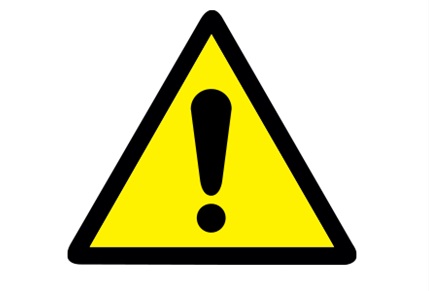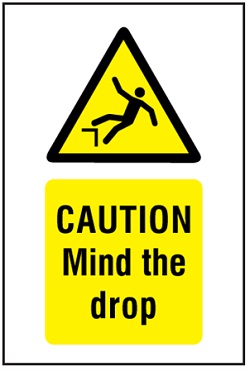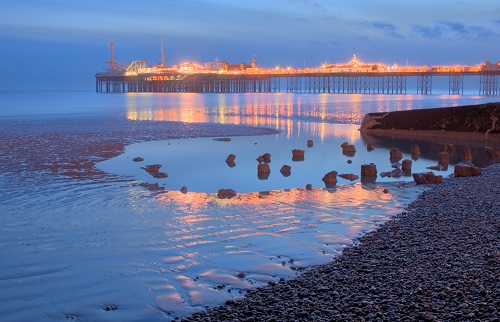
The Carrick Times - a weekly newspaper covering the town of Carrickfergus in Northern Ireland - ran a story last month that rather struck a chord with the team here at Label Source. The report stated that walkers had been ignoring safety signs that were put in place by the local council to keep people away from a dangerous coastal path that had recently seen a series of rockfalls:
"Signage has been erected to warn the public of the danger and barrier fencing has been installed to physically prevent public access...the path currently represents a very real and present danger"
It is hard to know what goes on in the mind of somebody who ignores warning signs and wanders into such a hazardous area. Standardised safety signs are designed to be as visible as possible, and so - unless the Carrickfergus council are positioning them out of sight - we can only assume that people are wilfully flouting the restrictions and hopping the barrier that would otherwise keep them out of harm's way.
This, sadly, is not the first we've heard of people ignoring safety signs and putting themselves at risk. We as a nation seem to think that health and safety is something we can afford to disregard, but measures like this are designed to keep you safe (whether from rockfalls or other hazards).
It's even worse when you realise that people in other parts of the world are going out of their way to get signs like these put in. Consider the story of the Australian woman whose granddaughter stepped on a venomous stonefish on the shore of a local river; ever since this incident, she has been battling to get a safety sign placed near the river, but the local authorities have so far been of very little help, it seems.
Clearly, we should be thankful for the health and safety laws that get safety signs where they need to be in the UK. Ignoring those signs is foolish and potentially very dangerous - if you've ever walked straight past a hazard warning without taking any notice, make sure it doesn't happen again!

We often hear of companies who have been taken to court over health and safety violations. Some organisations have been fined thousands of pounds because they didn't use the proper safety signs, or because a certain piece of equipment wasn't being used properly.
Sadly, though, accidents can't always be prevented, and the unthinkable does sometimes happen even in safety-compliant workplaces. Take, for example, the sad story of Nigel Chester: the 46-year-old safety inspector was visiting a Premier Foods factory in Nottinghamshire when he stepped through a 'door to nowhere' and suffered a 13ft fall, resulting in severe head injuries that eventually proved fatal.
Unusually for this type of case, though, the company was eventually judged to be free from blame, and Chester's tragic death ruled an accident. Why? Because the door (installed a decade ago during the construction of a gantry that was eventually deemed unnecessary) was locked and marked with an appropriate warning sign. Nigel Chester had unlocked the door using a master key, and he presumably didn't notice the sign, which read "Danger. Keep this door locked. Four metre fall to the floor if opened."
While this sign was sadly not enough to save the life of Mr Chester, it was enough to convince a jury that his death had been an accident, and it seems that the company will not be penalised. We are not suggesting that this should be any consolation to Mr Chester's family, nor indeed to the factory workers who witnessed the incident, but one must wonder how much sooner an accident like this would have occurred had the sign not been in place.
If there are any unmarked hazards in your workplace, be sure to label them with the correct safety signs as a matter of urgency. It's the law, and it could well save lives.
Source: Daily Mail
Electricity can kill! If hazards from electricity in the workplace are not clearly displayed, accidents can occur and some may even lead to death, as well as causing damage to property. People working within certain industries can be exposed to electricity more than others, and these are the people who are more likely to have an accident, especially if they are not informed of the dangers, and take the necessary precautions. However, virtually all companies have exposure to electricity to some extent, particularly with computers and printers.
It was reported that well over 100 accidents a year in the UK are due to electric shocks, with 89 serious injuries and 6 fatalities (in 2010/2011). Exposure to live electrical equipment can cause respiratory failure, heart attacks, electrical burn injuries and seizures. Other physical injuries can be caused by tripping over trailing wires or leads.
If there is any potential hazards in the workplace then count on us for your electrical safety signs. Our signs and labels will help identify the dangers, clearly informing and warning staff or building users of the potential risks from electricity. Our labels and signs inform workers of the voltage of the appliance (whether high or low voltage), live wires and terminals, electrical cables (overhead or underground), safety connections, isolation and safety devices, electrical arcing, and inspection labels, amongst others. An electric shock notice is also available to help inform workers of the actions needed to be taken in the event of injuries from contact with powered equipment, with recommended treatment guides including resuscitation, location of first aid equipment and emergency contact details.
So if you come into contact with electrical supply equipment, such as switchgear or busbars, cables or conductors, caution should be taken to make sure that the power source is disconnected. All cables, plugs, sockets and isolators should be maintained and checked regularly by competent personnel.
Make sure your workplace remains safe from electrical hazards, with our range of signs and labels providing a constant visual reminder of the need to take care when in contact with electrical equipment.

It wouldn't be Christmas without at least one farcical health and safety story. Previous Decembers have seen pantomime actors banned from throwing sweets into the audience and carol singers ordered to apply for permits; this year, attentions have turned towards Brighton, and the city's traditional Christmas Day swim.
According to a number of reports - most notably this one from Mail Online - Brighton and Hove City Council will be closing the beach on Christmas Day to prevent revellers from entering the water. According to the Mail, this move was sparked by two separate incidents:
- Back in October, an "experienced male swimmer" had to be rescued by the lifeguard after experiencing some difficulty.
- Christmas 2011 saw the rescue of another male swimmer during the Christmas Day swim itself.
Now, on the face of it, this ban may seem like an absurd overreaction (that's certainly how the Mail are portraying it). However...
- People have died in Christmas swims. Somewhat further down the page, that Mail article mentions a woman who died during "a similar swim in Hastings".
- Lifeguards don't work on Christmas Day. And nor should they be expected to! While the local swimming club do their part to ensure that everyone stays safe during the swim, the club's sea swimming coach has admitted that they do not have the capacity to oversee "4,000 ridiculous people in costumes...throwing themselves in the sea after drinking alcohol".
- Sea swimming is dangerous. Even strong swimmers have to be careful in the ocean, where the current can change at the drop of a hat. Moreover, hypothermia is a big concern at this time of year, especially with so many swimmers entering the water without wetsuits.
- Even one incident is too many. The Mail article opens with the following headline: "Brighton bans traditional Christmas Day dip because of health and safety fears after just TWO swimmers got into difficulty". It is slightly alarming to think that two incidents is not enough, especailly given that similar incidents have proved fatal elsewhere. How many people would have to drown before this ban ceased to be risible? Clearly, if even one life is at risk, then Brighton and Hove City Council have done the right thing.
While the aforementioned pantomime/caroling bans were rightfully dismissed - even by the HSE itself - it seems that this swimming ban has been put in place for a very good reason.
Further Reading: 5 Safety Tips for Christmas
Every December, you hear dozens of ridiculous stories about health and safety and how it's ruining Christmas in one way or another. People are told that they can't put up decorations, throw snowballs, put coins in Christmas puddings, and so forth. All of this is nonsense; in fact, no less an authority than the HSE itself has published a list of safety 'myths' that circulate every Christmas.
As always, though, the biggest problem with these stories is the fact that they devalue health and safety as a whole, drawing attention away from real dangers that are actually worth thinking about. We're not here today to talk about snowballs and sixpences, but the holiday season does bring with it a few genuine safety hazards, and that's what we'd like to highlight in this blog post.
Here, then, are 5 simple safety tips for you and your family to bear in mind this December:
- Watch out for bad weather. The 'most wonderful time of the year' coincides with some of the nastiest - and most unpredictable - weather we see here in the UK. Pay attention to weather warnings, be cautious around icy surfaces, and if it snows, don't drive anywhere unless you really need to.
- Make sure the turkey is properly cooked. Food poisoning is sadly quite common during the holidays. If you're in charge of cooking the Christmas dinner this year, make absolutely sure that EVERYTHING is properly cooked before you serve it up. Don't let a pink bit of meat ruin your entire day!
- Don't drink too much. While we're on the subject of poisoning, let's take a moment to talk about alcohol poisoning - we all enjoy a couple of drinks on Christmas night, but go too far and your evening in front of the TV could become a night in A&E.
- Be careful with naked flames. What would Christmas be without a few candles (not to mention the open fire on which you're roasting those chestnuts)? Naked flames are fine, but keep them away from flammable items and be sure to blow out the candles when you leave the room.
- Don't hurt yourself while decorating at height. Yes, okay, we had to include one point about the decorations. The only real danger here is height: if you're putting up lights or tinsel in a high-up, hard-to-reach area, be sure to use a secure stepladder rather than balancing on a wobbly chair.
Have a merry Christmas, and be sure to stay safe!